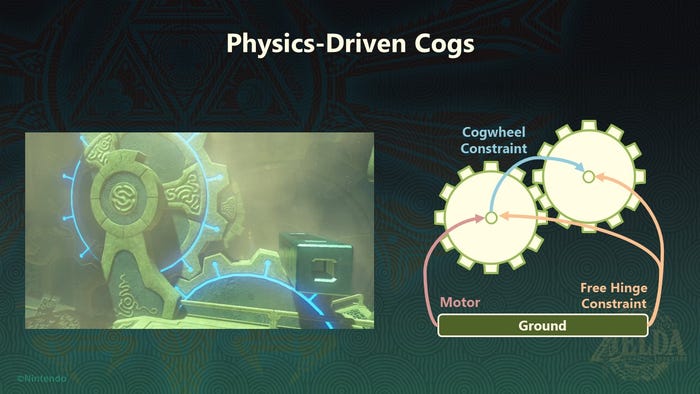
To talk about why The Legend of Zelda: The Tears of the Kingdom‘s physics system broke the brains of so many game developers, you need to look at its most mundane interactions.
In a 2024 panel at the Game Developers Conference, Tears of the Kingdom technical director Takuhiro Dohta, lead physics programmer Takahiro Takayama, and lead sound engineer Junya Osada took to the stage to break down the fundamentals of how the game’s physics system worked. The presentation covered topics such as calculating the appropriate physics for wheel resistance, turning cooking pots into vehicle joints, and architecting a “physics engine for sound.”
Those concepts will blow anyone’s mind. But game programmers are the ones who will melt down at the sight of a fully-functioning suspension bridge, like the one posted by Monomi Park game developer William Armstrong.
In an interview with Game Developer after their panel, Dohta, Takayama, and Osada took a moment to watch Armstrong’s video, all sharing a chuckle at a relatively simple example of their work in action.
“When you start connecting multiple objects together [in game development] things become very complicated very quickly,” Dohta said when asked why so many developers reacted with delight when seeing moments like this in Tears of the Kingdom.
Takayama said that if he put himself in the shoes of an independent observer, he said he would feel “surprised” that the system was functioning “pretty well.” “It speaks to the fact we were able to expand the type of gameplay…that we could accomplish in this game,” he said.
That short clip captures so much of the hard work that went into creating physics and sound systems for Tears of the Kingdom. In their panel, the three discussed how all the objects in the scene—the panels, the wheels, and the rock slab binding them—needed to be designed as independent objects whose properties be the foundation of “multiplicative gameplay,” a concept describing emergent gameplay that was introduced in Nintendo’s 2017 GDC presentation on the making of Breath of the Wild.
Each component of this year’s presentation—discussing the physics and the sound—deserves its own deep dive to fully capture Nintendo’s development process. Today, we’re going to dive into the physics system that powers Tears of the Kingdom.
“Sometimes it’s important to have the courage to push forward”
According to Takayama, early prototypes for Tears of the Kingdom experimented with the player’s ability to fuse any two objects in the game together. Once it was decided that this would be the foundation for the much-anticipated sequel to Breath of the Wild, he realized creating a physics system that supported such features would be “very, very difficult.”
“I said to myself ‘are we really doing this?! Development is going to be chaos.'” He said diving into this development mindset required “courage.”
This system would require the creation of the game’s many physics-driven objects, which would have mass, movement, and inertia controlled by velocity and acceleration. In the beginning, Takayama and his colleagues tried to alleviate some of their fear by creating objects that would not be strictly physics-driven.
Tears of the Kingdom was originally slated to have objects with Nintendo reffered to as “kinematic rigid body control.” These rigid bodies would be forcibly moved based on a velocity calculated using the speed of a hand-crafted animation.
The two systems did not mesh well together. Implementation these objects was easy but they had “infinite mass” and could break down in the face of physics-based calculations. Objects like giant interlocking gears and gates would break on a regular basis, which slowed down any attempt to design features around them.
“I would hear things like ‘it broke!’ or ‘it went flying!’,” he said. The exasperation in his responses from that time carried through to his presentation “I would respond with ‘I know, we’ll deal with it later,'” he would say.
So hand-crafted objects with kinematic rigid body control were out. Everything in Tears of the Kingdom needed to be physics-driven. Gears. Gates. If it could move, it couldn’t be rigid.
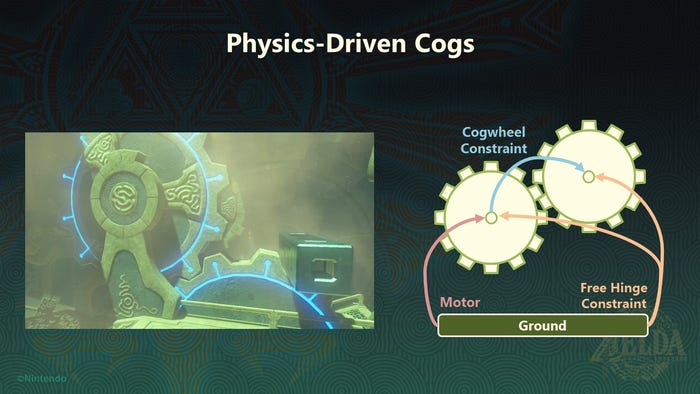
Image via Nintendo.
Making this shift would have the knock-on affect of impacting puzzle design across shrines and the open world. Now that everything was physics-driven, clever players could now explore multiple ways to solve any given puzzle.
All vehicles, even “pre-made” ones, are powered by the physical motion of their parts
Vehicles play a necessary role in Tears of the Kingdom. Players make them to traverse vast distances, ascend to floating temples in the sky, and safely navigate the corrupted surface of The Depths.
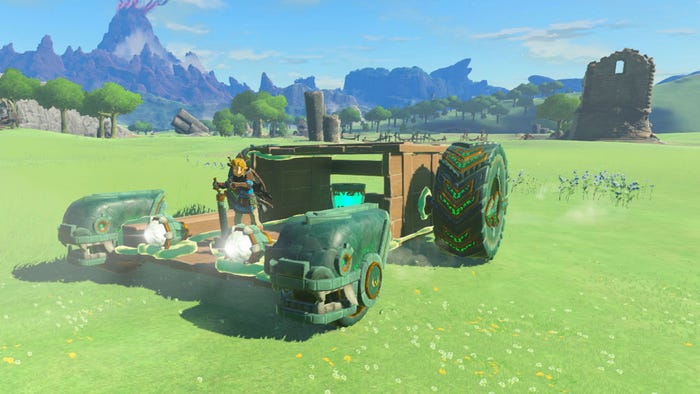
Image via Nintendo.
Sometimes they simply serve the purpose of letting players rain down hell from above.
The goal was that players would be able to create their own vehicles using the Fuse ability on different objects. By the time the game was ready to ship, the developers would create a vast library of objects that would each contain autonomous properties that would allow for vehicles to be created in an organic assembly process.
At the heart of most vehicles is the humble wheel. The wheel in Tears of the Kingdom contains three rigid bodies: the wheel itself, a motor, and a shaft. Torque from the motor transfers to the wheel via the shaft, and then friction between the ground and the wheel creates its forward motion.
You know, like in real life.
A breakthrough moment in the development of these wheels came when the developers experimented with implementing suspension—the process of creating relative movement between the wheels and the objects they were attached to—into the game.
Takayama credited the artist in charge of designing the look of the wheel with suggesting the idea for it to simulate suspension. Her idea represented the close relationship the physics team built with the rest of the studio to determine the “correct” feeling for how objects should behave.
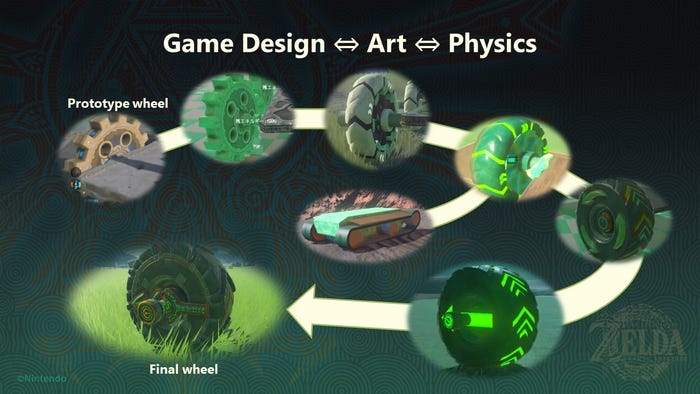
Image via Nintendo.
Now, the shaft holds up the motor via suspension, providing driving power to the wheel. The length of time a wheel makes contact with the ground is increased by having the wheel and its connecting motor shift up-and-down, and left-to-right, swaying with the movement of the machine. “There is also a range limit constraint and a clean constraint to control the range of movement,” said Takayama.
This physics-forward thinking led to the creation one of the wackiest “vehicle components” players would discover: the portable pot.
In Breath of the Wild, players could visit cooking pots to mix together various ingredients to make consumable food or potions. In Tears of the Kingdom, the developers wanted players to be able to deploy these pots anywhere in the world so they could cook dishes on the go.
Great idea. One problem. Hyrule is not made of flat surfaces. Placing a cooking pot out as they were previously programmed would result in spilled soup.
The solution was to put a “joint” at the bottom of the pot that would let it adapt to the terrain it was placed on. Simple fix. Nothing could go wrong. Right?
Wrong. Or…right? Whatever. Players turned it into a ball-and-joint socket system that could be used to increase wheel suspension, act as an arm for a robot, let lasers wiggle around to find targets, you name it. They’d stop at nothing to convert simple objects into tools of terror against the monsters of Hyrule.
“We were so happy to see that the joint on the portable pot has seen a whole range of use thanks to the creative imagination of so many players,” Takayama said as GDC attendees broke out into laughter at the sight of one player-created monstrosity appearing onscreen.
Objects had to be calibrated to feel as players expected them to feel
Though wheels and other objects were programmed to simulate real-world behavior, the real world is messy, dangerous, and not fun. That’s why we play/make video games.
Programming proper water resistance was one example where Nintendo had to supercharge the physics to make a more playful experience. The conventional (and easier) process for programming water physics would be to use to apply velocity decay in all directions as objects hit the water.
But that process didn’t feel “convincing.” Nintendo instead used the projected area of direction of an object’s velocity to calculate the resistance of the liquid it was dipping into. This helped create a “bounce” that felt good and drove dynamic interactions in the water.
Moving back to objects on land, Takayama described how the physics team needed to tweak objects based on the material properties assigned to them like wood, metal, stone, etc. The objects’ mass and movement are automatically calculated, and the volume necessary for that calculation is again calculated based on the object’s shape.
But again, objects in real life don’t move in fun ways. Objects in video games do. With the help of artists and designers, the team tweaked the values and appearance of objects to feel better for players. For instance, wooden boards, slabs of rock, and plates are all “thicker” than those in the real world so that they’re easier to see and control.
Before those adjustments, their calculated weight was “too heavy” thanks to the shape of the objects. You can see some of the final physics calculations in the slide below:
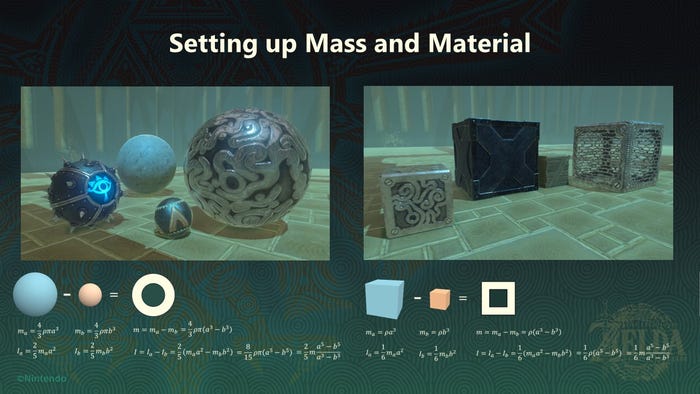
Image via Nintendo.
In our follow-up chat, Takayama described needing to just go on “gut feeling” to how objects should control.
He recalled picking up and feeling real boards and plates like the kinds you’d find in a hardware store, then comparing them to the in-game objects to determine if they need to be adjusted by say, making it three centimeters thinner.
These principles he discussed illustrate how the varying arms of the development team built an interlocking relationship to iterate and improve on the massive library of physics-driven objects, and the multiplicative gameplay they make possible.
Creating a physics-driven relationship with other developers
In separate comments during our chat with the trio, Dohta and Osada observed that these open-ended systems approaches brought various arms of the Tears of the Kingdom team together in ways that had never happened when making other Legend of Zelda titles.
Dohta explained that developers exploring “multiplicative gameplay” for themselves should be aware that systems like this greatly influence all areas of development. Making this physics system, for instance, influenced the development of the Fuse system that players use to bind objects together, which had the knock-on effect of the team creating a rules-based system for “naming” player-created objects when they appeared in their inventory.
Those rules also became essential for creating unique icons for the varied objects.
But beyond the internal dynamics at Nintendo, it was worth observing how the trio reacted to other developers’ reactions to their work. Dohta and Takayama repeatedly emphasized how they “largely have players in mind,” when making games, but admitted the positive reaction from their peers (some of whom voted to give them the “Best Technology” award at the 2024 Game Developers Choice Awards), deeply affected them.
“When I heard developers had such a positive reaction to something we created, it reaches a different part of my heart,” Dohta admitted, adding that it’s a “separate joy” to hear colleagues working in the same field were so impressed with his work.
Takayama echoed those sentiments, saying that “the fact we received compliments like this speaks to the fact there are developers who understand the complexity and challenges of implanting something like this.”
“Just knowing there are people who have tried to understand this and these challenges brings me joy and a sort of camaraderie—they’re colleagues in the same field and that warms my heart as well.”
The lead physics programmer had a message for developers inspired by what he and his colleagues achieved in making the physics system of Tears of the Kingdom:
“Taking on the challenge of creating such a system can be [difficult]. It’s a lot of work at the front end,” he said. “But as you create the system there’s a lot of new discoveries…a lot of new experiences that you can have as a developer once you get into the groove of things.”
“I just want to say that it can become very fun.”
Game Developer and Game Developers Conference are sibling organizations under Informa Tech.






